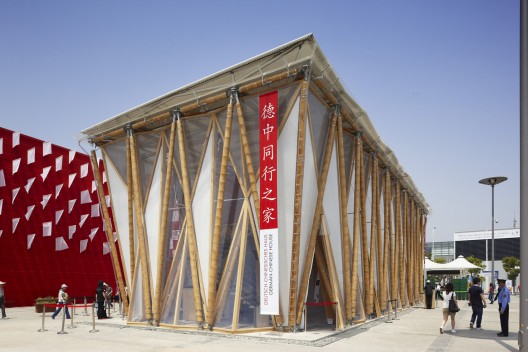
The event series “Germany and China – Moving Ahead Together” presents itself in spectacular fashion during its sixth and last station: the Expo 2010 in Shanghai. Designed by Markus Heinsdorff, the “German-Chinese House” is not only the architectural highlight of its Expo presence; it is also a forward-looking example for the use of natural construction material.
It is the only two-storey building at the Expo whose load-bearing structures are made of bamboo. The building is an artistic encounter with the theme of sustainable urbanisation, which was the focus of the three-year event series from 2007 to 2010.
More images and architect’s description after the break.
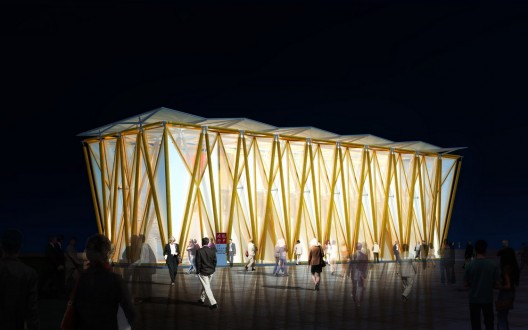
Tradition and high-tech
The “German-Chinese House” was designed by Markus Heinsdorff, a designer and installation artist. Heinsdorff already constructed around 20 delicate bamboo pavilions for the previous stations of “Germany and China – Moving Ahead Together”. In China bamboo enjoys a rich tradition as a construction material and Heinsdorff made this material the hallmark of the event series. Heinsdorff’s buildings are modern, multifunctional rooms as well as works of art combined in one.
They represent a symbiosis of natural and high-tech materials. As a construction material, bamboo is especially environmentally friendly and efficient in the use of resources. The grass grows up to 30 centimetres per day – faster than any other plant. Working with bamboo does not require the tree to be cut down.There is hardly any other material that is as elastic while at the same time as hard and firm as bamboo. Bamboo also possesses a unique charm.
The German-Chinese architecture practice MUDI in Shanghai was responsible for the planning and the comprehensive approval process. The stand construction company Shanghai Oriental Expo Services has been supervising the construction.
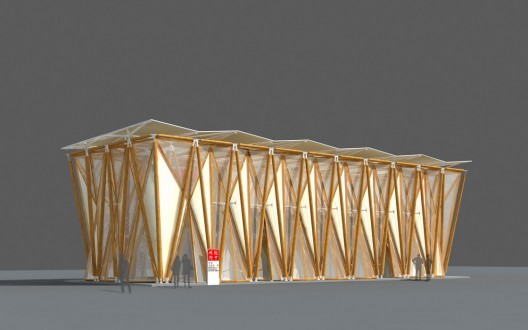
Mobile and recyclable
The “German-Chinese House” is a bamboo membrane building with a walk-through surface area of 330 square metres spread over the two floors. For the roof’s supporting construction, Markus Heinsdorff used eight-metre-long canes of Julong bamboo, a rare and particularly long type of bamboo from South China.
Before the actual construction, the bamboo was treated with a special fire-resistant chemical and has received a certification for fire resistance. In the interior of the building, the artist worked with glue-laminated bamboo segments. For both materials, new connecting and finishing techniques, which were developed especially for this project, were used. The supporting beams of the bamboo segments, which measure up to six metres long, make a self-supporting room possible on the upper floor. Connecting joints of steel on the roof hold together the bamboo supporting frame structure.
They are set in HVFA concrete with a high concentration of flue ash. The roof consists of special PVC membranes. On the building’s façade, the bamboo has been combined with light-translucent ETFE films. The building is environmentally friendly and mobile: it can be taken apart and reassembled elsewhere. All materials are either reusable or completely recyclable.
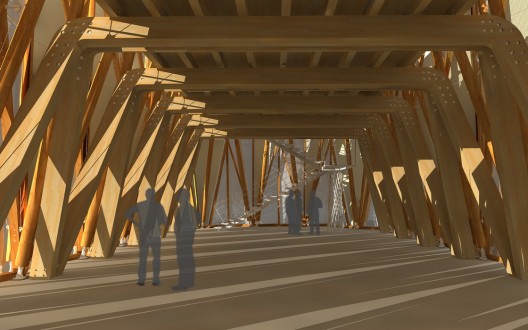
Futuristic and multifunctional
The design of the “German-Chinese House” has the effect of being light, elegant and futuristic. It combines stylistic elements from both cultures. The roof surfaces and supporting beams in the interior remind one of bamboo fans or paper umbrellas, while the facade, thanks to its form and translucence, calls to mind a finely polished gemstone. The triangular entrances and exits resemble Gothic building forms.
Both ends of the hall are open spaces. The house is covered with a white, shiny material that has been stretched between the bamboo canes and makes the house look like a beautifully lit lamp at night.
The building contains exhibition, game and conference areas. Along the longitudinal axis of the large hall on the ground floor, visitors can take part in an interactive city game. The first floor in four-metre height is accessible by a steel staircase, which is supported by a woven supporting pillar. Here, visitors will find an 80-square-meter-large lounge and conference centre, which is open to the roof structure.
For noise protection, the room has been completely enclosed with 12-millimetre-thick transparent polycarbonate plates. Also on the upper floor are three oval structures connected to each other — in the colours of the German flag.
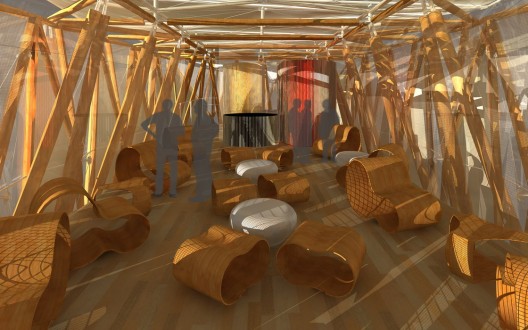
The building’s built-in components and furniture were custom-made for the “German-Chinese House”. They are practical, futuristic and comfortable – and are also works of art themselves. Here, too, the principles of sustainability are visible. The minimal use of resources and the use of environmentally-friendly materials like bamboo take priority. The bamboo furniture is light, flexible and high-strength.
Various layers of thin bamboo veneer have been glued together in different forms. The result is comfortable, resilient chairs, seats and tables, which instantly can be stacked together to create sculptures within the space.
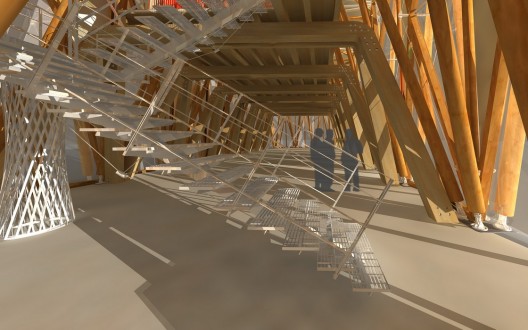
More about “Germany and China – Moving Ahead Together”:
www.dezhongtongxing.com / www.deutschland-und-china.com
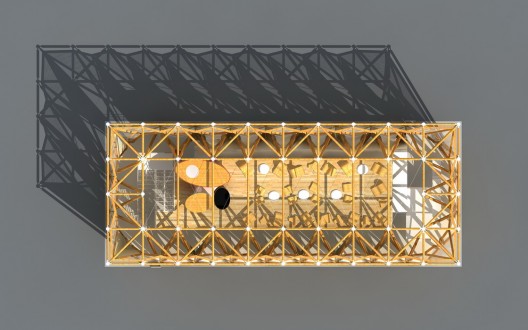


















![Validate my RSS feed [Valid RSS]](http://validator.w3.org/feed/images/valid-rss-rogers.png)
![Validate my Atom 1.0 feed [Valid Atom 1.0]](http://validator.w3.org/feed/images/valid-atom.png)
